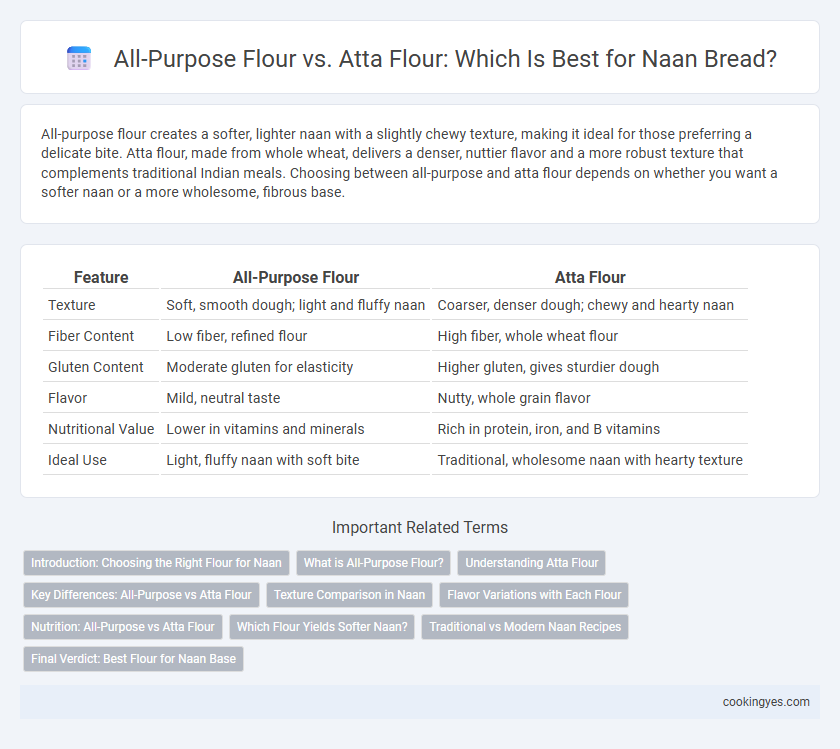All-purpose flour creates a softer, lighter naan with a slightly chewy texture, making it ideal for those preferring a delicate bite. Atta flour, made from whole wheat, delivers a denser, nuttier flavor and a more robust texture that complements traditional Indian meals. Choosing between all-purpose and atta flour depends on whether you want a softer naan or a more wholesome, fibrous base.
Table of Comparison
| Feature | All-Purpose Flour | Atta Flour |
|---|---|---|
| Texture | Soft, smooth dough; light and fluffy naan | Coarser, denser dough; chewy and hearty naan |
| Fiber Content | Low fiber, refined flour | High fiber, whole wheat flour |
| Gluten Content | Moderate gluten for elasticity | Higher gluten, gives sturdier dough |
| Flavor | Mild, neutral taste | Nutty, whole grain flavor |
| Nutritional Value | Lower in vitamins and minerals | Rich in protein, iron, and B vitamins |
| Ideal Use | Light, fluffy naan with soft bite | Traditional, wholesome naan with hearty texture |
Introduction: Choosing the Right Flour for Naan
All-purpose flour and atta flour offer distinct textures and flavors for naan, with all-purpose flour yielding a softer, fluffier bread, while atta flour provides a traditional, slightly denser and more nutrient-rich base. The protein content in all-purpose flour typically ranges from 10-12%, promoting gluten development ideal for elasticity, whereas atta flour, made from whole wheat, contains higher fiber and minerals that enhance the naan's rustic taste and nutritional profile. Selecting the right flour depends on the desired naan texture and health considerations, balancing softness with authenticity.
What is All-Purpose Flour?
All-purpose flour is a versatile wheat flour made from a blend of hard and soft wheat, offering a moderate protein content of approximately 10-12%, which provides a balanced gluten structure ideal for various baked goods. Unlike atta flour, commonly used in traditional Indian cooking, all-purpose flour produces a softer and lighter texture in naan due to its finer grind and lower fiber content. This flour's adaptability makes it a popular choice for achieving fluffy, tender naan bread with a slightly chewy bite.
Understanding Atta Flour
Atta flour, traditionally used in Indian cooking, is whole wheat flour with a coarser texture and higher fiber content compared to all-purpose flour, which is refined and softer. Using atta flour for naan results in a denser, nuttier bread with enhanced nutritional value, rich in protein and dietary fiber. The unique gluten structure of atta flour provides a chewier texture, making it ideal for authentic, flavorful naan base.
Key Differences: All-Purpose vs Atta Flour
All-purpose flour creates a softer and fluffier naan due to its moderate protein content, making it ideal for a tender texture. Atta flour, with higher fiber and whole wheat content, results in a denser, more nutritious naan that has a distinctly hearty flavor. The choice between all-purpose and atta flour affects the naan's chewiness, color, and nutritional profile, catering to different taste preferences and dietary needs.
Texture Comparison in Naan
All-purpose flour produces a softer, lighter naan with a tender crumb, ideal for achieving a fluffy texture. Atta flour, with its higher fiber and gluten content, results in a denser, chewier naan with a more rustic, hearty bite. Texture differences stem from the refined nature of all-purpose flour versus the whole wheat composition of atta, influencing moisture retention and elasticity in the dough.
Flavor Variations with Each Flour
All-purpose flour produces a softer, lighter naan with a neutral taste that allows toppings and spices to shine, while atta flour offers a denser, earthier texture with a slightly nutty flavor that adds depth and authenticity to traditional naan. The higher gluten content in all-purpose flour creates a chewy bite, whereas the bran in atta flour contributes a rustic, wholesome aroma and enhances the overall flavor complexity. Selecting between all-purpose and atta flour impacts the naan's flavor profile and texture, influencing its suitability for different regional recipes and personal preferences.
Nutrition: All-Purpose vs Atta Flour
Atta flour, used traditionally for naan, retains the bran and germ, providing higher fiber content and essential nutrients like iron and magnesium compared to all-purpose flour. All-purpose flour is more refined, resulting in fewer vitamins and minerals but a softer texture in naan. Choosing atta flour enhances the nutritional profile with increased protein and complex carbohydrates beneficial for sustained energy.
Which Flour Yields Softer Naan?
Atta flour, traditionally used in Indian cooking, contains more bran and fiber than all-purpose flour, resulting in a denser, slightly chewy naan texture. All-purpose flour, with its higher gluten content and finer milling, yields a softer, lighter naan due to better gluten development and moisture retention. For achieving the softest naan base, all-purpose flour is generally preferred because it creates a tender crumb with more elasticity.
Traditional vs Modern Naan Recipes
Traditional naan recipes typically use atta flour, a whole wheat flour that imparts a distinct nutty flavor and chewy texture essential to authentic Indian flatbreads. Modern naan recipes often incorporate all-purpose flour for a softer, lighter texture and quicker preparation, appealing to contemporary tastes. The choice between atta and all-purpose flour fundamentally influences the naan's texture, flavor, and nutritional profile, balancing tradition with convenience.
Final Verdict: Best Flour for Naan Base
All-purpose flour yields a soft, tender naan with a slightly chewy texture, making it ideal for a versatile and easily digestible base. Atta flour, richer in fiber and nutrients, produces a denser, earthier naan with a robust flavor and a wholesome bite. For the perfect naan base combining softness and authentic taste, a blend of 70% all-purpose flour and 30% atta flour is recommended, balancing fluffiness with nutritional value.
All-purpose flour vs Atta flour for Naan base Infographic

 cookingyes.com
cookingyes.com